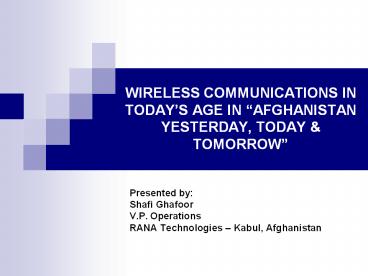WIRELESS COMMUNICATIONS IN TODAY - PowerPoint PPT Presentation
1 / 12
Title:
WIRELESS COMMUNICATIONS IN TODAY
Description:
(AFGHAN TELECOM) 18 National ISP licensed & operational companies ... (RANA Technologies and Afghan Telecom) One pay-phone licensed company (Afghan Telecom) ... – PowerPoint PPT presentation
Number of Views:108
Avg rating:3.0/5.0
Title: WIRELESS COMMUNICATIONS IN TODAY
1
WIRELESS COMMUNICATIONS IN TODAYS AGE IN
AFGHANISTAN YESTERDAY, TODAY TOMORROW
- Presented by
- Shafi Ghafoor
- V.P. Operations
- RANA Technologies Kabul, Afghanistan
2
Afghanistan - An Overview
- CURRENT POPULATION
- Current Total Population 28 Million
- Current Rural Population 19 Million (70 )
- Current Urban Population - 09 Million (30 )
- Population Growth Rate Per Annum 2
- Current GDP
- Currency Afghani
- GDP 20 Bn ()
- GDP Per Capita 714 ()
- GDP Real Growth 18 20
- GDP Composition Agriculture 70, Industry
15, Services 15
3
Current Communications Sector Scenario
- Four top international GSM companies
- (ROSHAN AWCC MTN-AREEBA ETISALAT)
- One State-owned CDMA company
- (AFGHAN TELECOM)
- 18 National ISP licensed operational companies
- Two National WIMAX licensed company
- (RANA Technologies and Afghan Telecom)
- One pay-phone licensed company (Afghan Telecom)
- Multiple regional based CDMA licensed companies
4
Major Communications On-going Projects
- OFC Ring Backbone Project
- Fixed Line Network Expansion project
- District Level Communications Roll Out Project
- Village Level Communications Roll Out Project
- Broad Band Services on Fixed Line Networks
- Internet Exchange Point Project
- National Data Centre Build-up Project
- Access Networks Project
- International Exchange Project
- Full Mobility Project for CDMA Network
5
Current Challenges
- Security
- Lack of Educated, Trained Skilled manpower
- Non-prioritization of Capacity Building
Strategies - Lack of Communications Infrastructure Building
Companies - Lack of Roads and Transportation means for
accessing Remote Areas
6
Some Positive ICT Policy Initiatives
- Privatization of GSM sector which brought a total
investment of more that One billion US Dollars
in the last 3 years. - Roll out of OFC Backbone Project on the Ring Road
of Afghanistan - Focus on Govt communication projects like GCN,
VCN and DCN - Development Initiative for Access Networks for
Remote Areas in 2008-2009 - Initiative to Roll out Broad band Services in
2008-2009 - Telecentre Concept for Districts and Villages
under GCN, DCN and VCN
7
Wireless Communications Convergence
Opportunities in Afghanistan
- Wimax network on 3.4 GHz frequency already
successfully deployed in top 5 cities of
Afghanistan - Quick Roll out of Wi-Fi based networks
- UNIFIED COMMUNICATIONS through Wireless route
- (Companies like Siemens aggressively working on
this initiatives) - Broad band Internet Cafes on the Optical Fiber
Routes - Broad band Internet on Existing Fixed Line
Networks in 06 Major Cities - Demand of highly complex, integrated Unified
communication networks is high in Afghanistan
8
Ministry of Communications Information
Technologies Vision for Afghanistan
- Wide coverage of services in all cities, towns
and 6000 villages - Improved quality, Lower tariffs (halved) in next
3 years - Competitive environment with 5 Telecom Companies
providing services in next 1 year - National optical fiber project backbone completed
providing high quality low cost ground based
national and international connectivity in next 2
years - Cumulative investments in telecom of over 1.5
billion in next 3 years - 6 million phone users in next 4 years (20 of
population) - 50,000 jobs created in next 4 years
- Government revenues from Telecom in next 10 years
- USD 2 billion
9
Afghanistans Telecom Policies
- PRINCIPLES
- Create a legal and regulatory environment that
nurtures and accelerates industry growth. - Engage private investment to the greatest extent
possible. - Establish a level playing field for competition.
- Introduce market liberalization.
- Encourage the usage of Internet and Information
and communications technologies
10
Afghanistan Telecom Policies
- GOALS
- To quickly restore the productive capacity of the
exiting public networks with expanded and
upgraded systems in all primary and secondary
cities. - Establish a National long distance network to
provide basic Voice, Data and Internet
communications to even the remotest regions of
Afghanistan. - Establish a national Back-bone network around the
country that connects major Domestic population
centers and our International neighbors. - Issue additional nation-wide licenses for fixed
telecommunications services. - Issue Multiple ISP licenses.
- Increase Tele-density from the present 0.5 to
15 by 2010. - Increase mobile tele-density from the present
2.5 to 30 by 2010. - Maximize the use and value of radio frequency
spectrum through competitive international
tenders. - Establish tele-centers in all the 423 small
administrative centers and communities.
11
Targets set by MCIT-Afghanistan
12
THANK YOU!































